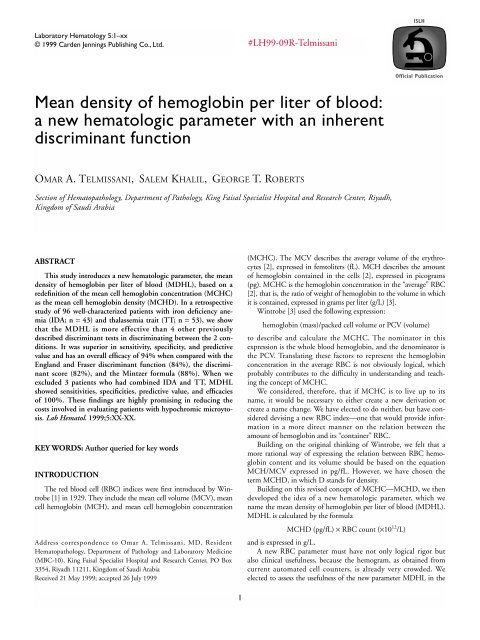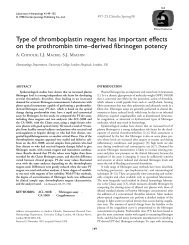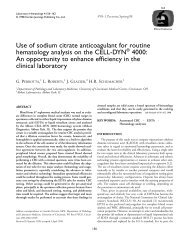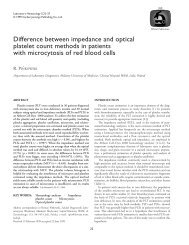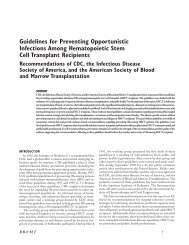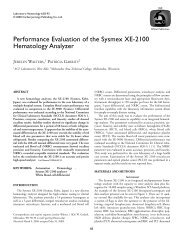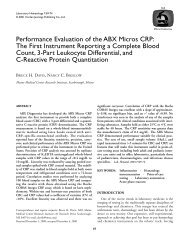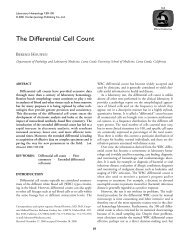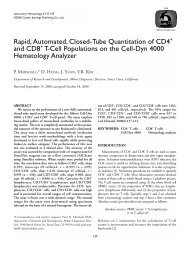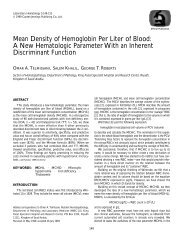Mean density of hemoglobin per liter of blood - Carden Jennings ...
Mean density of hemoglobin per liter of blood - Carden Jennings ...
Mean density of hemoglobin per liter of blood - Carden Jennings ...
You also want an ePaper? Increase the reach of your titles
YUMPU automatically turns print PDFs into web optimized ePapers that Google loves.
ISLH<br />
Laboratory Hematology 5:1–xx<br />
© 1999 <strong>Carden</strong> <strong>Jennings</strong> Publishing Co., Ltd.<br />
#LH99-09R-Telmissani<br />
Official Publication<br />
<strong>Mean</strong> <strong>density</strong> <strong>of</strong> <strong>hemoglobin</strong> <strong>per</strong> <strong>liter</strong> <strong>of</strong> <strong>blood</strong>:<br />
a new hematologic parameter with an inherent<br />
discriminant function<br />
OMAR A. TELMISSANI, SALEM KHALIL, GEORGE T. ROBERTS<br />
Section <strong>of</strong> Hematopathology, Department <strong>of</strong> Pathology, King Faisal Specialist Hospital and Research Center, Riyadh,<br />
Kingdom <strong>of</strong> Saudi Arabia<br />
ABSTRACT<br />
This study introduces a new hematologic parameter, the mean<br />
<strong>density</strong> <strong>of</strong> <strong>hemoglobin</strong> <strong>per</strong> <strong>liter</strong> <strong>of</strong> <strong>blood</strong> (MDHL), based on a<br />
redefinition <strong>of</strong> the mean cell <strong>hemoglobin</strong> concentration (MCHC)<br />
as the mean cell <strong>hemoglobin</strong> <strong>density</strong> (MCHD). In a retrospective<br />
study <strong>of</strong> 96 well-characterized patients with iron deficiency anemia<br />
(IDA; n = 43) and thalassemia trait (TT; n = 53), we show<br />
that the MDHL is more effective than 4 other previously<br />
described discriminant tests in discriminating between the 2 conditions.<br />
It was su<strong>per</strong>ior in sensitivity, specificity, and predictive<br />
value and has an overall efficacy <strong>of</strong> 94% when compared with the<br />
England and Fraser discriminant function (84%), the discriminant<br />
score (82%), and the Mintzer formula (88%). When we<br />
excluded 3 patients who had combined IDA and TT, MDHL<br />
showed sensitivities, specificities, predictive value, and efficacies<br />
<strong>of</strong> 100%. These findings are highly promising in reducing the<br />
costs involved in evaluating patients with hypochromic microytosis.<br />
Lab Hematol. 1999;5:XX-XX.<br />
KEY WORDS: Author queried for key words<br />
INTRODUCTION<br />
The red <strong>blood</strong> cell (RBC) indices were first introduced by Wintrobe<br />
[1] in 1929. They include the mean cell volume (MCV), mean<br />
cell <strong>hemoglobin</strong> (MCH), and mean cell <strong>hemoglobin</strong> concentration<br />
Address correspondence to Omar A. Telmissani, MD, Resident<br />
Hematopathology, Department <strong>of</strong> Pathology and Laboratory Medicine<br />
(MBC-10), King Faisal Specialist Hospital and Research Center, PO Box<br />
3354, Riyadh 11211, Kingdom <strong>of</strong> Saudi Arabia<br />
Received 21 May 1999; accepted 26 July 1999<br />
(MCHC). The MCV describes the average volume <strong>of</strong> the erythrocytes<br />
[2], expressed in femto<strong>liter</strong>s (fL). MCH describes the amount<br />
<strong>of</strong> <strong>hemoglobin</strong> contained in the cells [2], expressed in picograms<br />
(pg). MCHC is the <strong>hemoglobin</strong> concentration in the “average” RBC<br />
[2], that is, the ratio <strong>of</strong> weight <strong>of</strong> <strong>hemoglobin</strong> to the volume in which<br />
it is contained, expressed in grams <strong>per</strong> <strong>liter</strong> (g/L) [3].<br />
Wintrobe [3] used the following expression:<br />
<strong>hemoglobin</strong> (mass)/packed cell volume or PCV (volume)<br />
to describe and calculate the MCHC. The nominator in this<br />
expression is the whole <strong>blood</strong> <strong>hemoglobin</strong>, and the denominator is<br />
the PCV. Translating these factors to represent the <strong>hemoglobin</strong><br />
concentration in the average RBC is not obviously logical, which<br />
probably contributes to the difficulty in understanding and teaching<br />
the concept <strong>of</strong> MCHC.<br />
We considered, therefore, that if MCHC is to live up to its<br />
name, it would be necessary to either create a new derivation or<br />
create a name change. We have elected to do neither, but have considered<br />
devising a new RBC index—one that would provide information<br />
in a more direct manner on the relation between the<br />
amount <strong>of</strong> <strong>hemoglobin</strong> and its “container” RBC.<br />
Building on the original thinking <strong>of</strong> Wintrobe, we felt that a<br />
more rational way <strong>of</strong> expressing the relation between RBC <strong>hemoglobin</strong><br />
content and its volume should be based on the equation<br />
MCH/MCV expressed in pg/fL. However, we have chosen the<br />
term MCHD, in which D stands for <strong>density</strong>.<br />
Building on this revised concept <strong>of</strong> MCHC—MCHD, we then<br />
developed the idea <strong>of</strong> a new hematologic parameter, which we<br />
name the mean <strong>density</strong> <strong>of</strong> <strong>hemoglobin</strong> <strong>per</strong> <strong>liter</strong> <strong>of</strong> <strong>blood</strong> (MDHL).<br />
MDHL is calculated by the formula<br />
MCHD (pg/fL) × RBC count (×10 12 /L)<br />
and is expressed in g/L.<br />
A new RBC parameter must have not only logical rigor but<br />
also clinical usefulness, because the hemogram, as obtained from<br />
current automated cell counters, is already very crowded. We<br />
elected to assess the usefulness <strong>of</strong> the new parameter MDHL in the<br />
1
2 OA Telmissani et al.<br />
evaluation <strong>of</strong> the common clinical hematologic problem <strong>of</strong><br />
hypochromic microcytosis: how to discriminate between iron deficiency<br />
anemia (IDA) and thalassemia trait (TT). In common clinical<br />
practice, differentiation is based on the demonstration <strong>of</strong><br />
reduced serum iron, increased total iron-binding capacity, or<br />
reduced serum ferritin (for IDA). For identifying TT or normal<br />
iron status, estimation <strong>of</strong> <strong>hemoglobin</strong> (eg, by electrophoresis) is<br />
required. However, these diagnostic procedures are not inexpensive,<br />
especially when, in addition, α-thalassemia trait (α-TT) is considered.<br />
In some cases, it may require globin-chain synthesis rate<br />
determination or even α-globin gene analysis may be required.<br />
To measure the efficacy <strong>of</strong> MDHL, we challenged it against several<br />
formulas that have been proposed to differentiate between IDA<br />
and TT. First, England and Fraser [4,5] introduced a linear discriminant<br />
function (DF) derived from the MCV, RBC count (RBCC),<br />
and <strong>hemoglobin</strong> (Hb) concentration. DF was <strong>of</strong> the form MCV –<br />
RBCC – (5 × Hb) – k, where k is a constant determined by the<br />
method used to calibrate the cell counter. Positive DF values indicate<br />
IDA and negative values indicate TT. Mentzer [6] suggested that an<br />
even simpler index, MCV/RBC, was equally useful for distinguishing<br />
the 2 conditions, with values below 13 indicating TT. Shine and Lal<br />
[7] used (MCV) 2 × MCH in screening for TT, with values <strong>of</strong> less<br />
than 1530 being regarded as diagnostic <strong>of</strong> the condition.<br />
Another formula is the discrimination score (DS), [8] based on<br />
the following equation:<br />
(0.096 × MCV) + (0.415 × RDW) – (0.139 × RBC) – 12.722 for men,<br />
and (0.096 × MCV) + (0.415 × RDW) – 12.722 for women,<br />
where RDW indicates red cell distribution width, with 0.3095 as<br />
a cut<strong>of</strong>f point, below which TT is probable and above which IDA<br />
is likely. Unfortunately, all <strong>of</strong> these approaches have significant<br />
limitations. First, their incorporation in the complete <strong>blood</strong> cell<br />
(CBC) hemogram is impractical because the mathematical procedures<br />
are elaborate. Second, their sensitivity and specificity are<br />
not high, resulting in considerable imprecision in discriminating<br />
between IDA and TT.<br />
MATERIALS AND METHODS<br />
The patients, retrospectively selected randomly, were older than<br />
12 years with microcytic hypochromic <strong>blood</strong> picture, Hb >70 g/L<br />
and MCV
<strong>Mean</strong> Density <strong>of</strong> Hemoglobin Per Liter <strong>of</strong> Blood 3<br />
TABLE 2. Distribution <strong>of</strong> 96 cases <strong>of</strong> iron deficiency anemia and<br />
thalassemia<br />
IDA TT Total<br />
Male 16 (1)* 31 47<br />
Female 27 22 (2) † 49<br />
Total 43 53 96<br />
IDA, iron deficiency anemia;TT, thalassemia trait<br />
*One patient with associated TT.<br />
† Two patients with associated IDA.<br />
those whose MDHL value was greater than the mean were more<br />
likely to have TT (+PV <strong>of</strong> 100%) (Fig.1). When compared with 4<br />
previously reported discriminant formulas, the MDHL showed the<br />
highest efficacy in the diagnosis <strong>of</strong> IDA and TT compared with the<br />
others. These comparisons are summarized in Table 3. Although we<br />
included the (MCV) 2 × MCH formula, it is not strictly comparable<br />
to the others, because it is, as originally described, intended for<br />
identifying thalassemia patients only.<br />
DISCUSSION<br />
FIGURE 1. Efficacy <strong>of</strong> MDHL in discriminating between IDA<br />
and TT. PV+, positive predictive value; PV–, negative predictive<br />
value; IDA, iron deficiency anemia; TT. thalassemia trait.<br />
We have introduced the new RBC parameters, MCHD and<br />
MDHL, to rationalize the concepts <strong>of</strong> <strong>hemoglobin</strong> distribution<br />
within the average RBC and in <strong>blood</strong>. MCHD is a more direct<br />
way <strong>of</strong> assessing the amount <strong>of</strong> <strong>hemoglobin</strong> in the average RBC,<br />
because it indicates how much <strong>hemoglobin</strong> is contained within<br />
the RBC in relation to its volume. MDHL, derived from<br />
MCHD, gives an estimate <strong>of</strong> the <strong>hemoglobin</strong> dis<strong>per</strong>sal <strong>per</strong> <strong>liter</strong> <strong>of</strong><br />
<strong>blood</strong>.<br />
How does MCHD differ from MCHC Apart from the name,<br />
by which MCHD more correctly describes the concept without<br />
confusion, MCHD differs also by the scale <strong>of</strong> the unit <strong>of</strong> measure<br />
(a factor <strong>of</strong> 10 -12 ). Moreover, the expression <strong>of</strong> MCHD in pg/fL<br />
appears much more in line with the other RBC indices, MCV and<br />
MCH, and also harmonizes well with MDHL.<br />
The use <strong>of</strong> the term “<strong>density</strong>” should not be equated with light<br />
scattering by the individual RBC. Light-scatter methods, using<br />
laser technique, for example, can determine the <strong>hemoglobin</strong> content<br />
<strong>of</strong> individual RBC accurately, but the information derived has<br />
not been applied to the problem <strong>of</strong> distinguishing between IDA<br />
and TT [11]. Likewise, RBC <strong>density</strong>, with which MDHL is not to<br />
be confused, deals with the <strong>density</strong> <strong>of</strong> the RBC, as estimated by<br />
buoyancy gradient techniques, for example. Significant increases in<br />
RBC <strong>density</strong> are seen in sickle cell syndromes and Hb CC [12],<br />
but, again, this parameter has not been applied to distinguish<br />
between IDA and TT.<br />
We next assessed the clinical validity <strong>of</strong> our new parameters in<br />
differentiating between IDA and TT without resorting to expensive<br />
testing. These entities can sometimes exhibit the same degree<br />
<strong>of</strong> anemia, microcytosis, and hypochromasia, but in only a limited<br />
number <strong>of</strong> cases are CBC parameters helpful in distinguishing<br />
between the 2 conditions. For this differentiation exercise, MCV,<br />
MCH, and MCHC are most frequently used. However, none is<br />
sensitive enough to enable a clear distinction between the 2 types<br />
<strong>of</strong> hypochromic microcytosis, although it is usually claimed that<br />
MCHC is more frequently below normal in IDA. Because <strong>of</strong> this<br />
inability <strong>of</strong> the routine indices to differentiate, formulas have been<br />
devised to achieve this objective. Some <strong>of</strong> these formulas are complicated,<br />
however, and not precise enough to be useful in a significant<br />
minority <strong>of</strong> cases.<br />
Using MDHL in this series <strong>of</strong> 96 patients, we show that those<br />
with IDA have an MDHL lower than or equal to the mean<br />
TABLE 3. Comparison between the new MDHL parameter and the 4 reported formulas<br />
Sensitivity (%) Specificity (%) PV+ (%) PV– (%) Efficacy (%)<br />
IDA TT IDA TT IDA TT IDA TT IDA TT<br />
MDHL 100 90 90 100 84 100 100 84 94 94<br />
Formula 1 — 100 — 7.5 — 56.9 — 100 — 58.3<br />
Formula 2 95.3 83 83 95.3 82 95.6 95.6 82 88.5 88.5<br />
DS 81.4 83 83 81.4 79.5 86.6 84 79.5 82.3 82.3<br />
DF 97.7 73.6 73.6 97.7 75 97.5 97.5 75 84.4 84.4<br />
Formula 1: MCV 2 × MCH [8]; Formula 2: MCV/RBC [7].<br />
DF, discrimination function; DS, discrimination score; IDA, iron deficiency anemia; MCH, mean cell <strong>hemoglobin</strong> ; MCV mean cell volume; MDHL, mean <strong>density</strong><br />
<strong>of</strong> <strong>hemoglobin</strong> <strong>per</strong> <strong>liter</strong> <strong>of</strong> <strong>blood</strong>; PV, predictive value; RBC, red <strong>blood</strong> cell;TT, thalassemia trait.
4 OA Telmissani et al.<br />
MDHL in a normal reference population, whereas patients with<br />
TT have an MDHL higher than the mean. For discrimination<br />
between IDA and TT, we evaluated MDHL for sensitivity, specificity,<br />
predictive value, and efficacy, compared with the previously<br />
reported formulas (Fig.1). As shown in Table 3, sensitivity, specificity,<br />
predictive value, and efficacy were su<strong>per</strong>ior to those obtained<br />
with the other formulas. Seven female patients who had IDA and<br />
were under specific therapy were correctly classified by a low<br />
MDHL. What is extraordinary about MDHL is that when we<br />
exclude 3 patients (2 women and 1 man) who had combined IDA<br />
and β-TT (IDA prevailing in 2 patients and TT in the other<br />
patient), the sensitivities, specificities (negative and a positive PV)<br />
reached 100%. This discriminating ability holds whether β-TT or<br />
α-TT is considered.<br />
An intriguing observation is that, although the mean MDHL<br />
provided a clear discriminator between IDA and TT, 50% <strong>of</strong> the<br />
healthy subjects must, by definition, have a lower MDHL, whereas<br />
the other 50% must have a higher MDHL. Thus, MDHL is <strong>of</strong><br />
no apparent value in subjects with normal MCV and MCH. But,<br />
when appropriately applied, MDHL provides an extremely powerful<br />
screening tool for discriminating between IDA and TT. Programming<br />
new or even present-generation counters would be a<br />
relatively simple matter that could result in considerable savings in<br />
the general practice <strong>of</strong> hematology.<br />
ACKNOWLEDGMENTS<br />
We wish to thank the technical staff <strong>of</strong> the Section <strong>of</strong> Hematology,<br />
Department <strong>of</strong> Pathology and Laboratory Medicine,<br />
KFSH&RC, for their unstinting help during this project. Special<br />
thanks to Dr. Samir Ballas for his advice on the preparation <strong>of</strong> the<br />
manuscript.<br />
REFERENCES<br />
1. WINTROBE MM. A simple and accurate hematocrit. J Lab Clin Med.<br />
1929;15:287.<br />
2. WINTROBE MM. Wintrobe’s Clinical Hematology. 8th ed. London: 1981:8.<br />
3. WINTROBE MM. Wintrobe’s Clinical Hematology. 8th ed. London:<br />
1981:18.<br />
4. ENGLAND JM, FRASER PM. Differentiation <strong>of</strong> iron deficiency from thalassaemia<br />
trait by routine <strong>blood</strong>-count. Lancet. 1973;1:449-452.<br />
5. ENGLAND JM, FRASER PM. Discrimination between iron-deficiency and<br />
heterozygous-thalassemia syndromes in differential diagnosis <strong>of</strong> microcytosis.<br />
Lancet. 1979;1:145-148.<br />
6. MENTZER WC. Differentiation <strong>of</strong> iron deficiency from thalassaemia trait.<br />
Lancet. 1973;1:882.<br />
7. SHINE I, LAL S. Strategy to detect beta-thalassemia minor. Lancet.<br />
1977;1:692-694.<br />
8. FAIRBANKS VF, HINES JD, MAZZA JJ, HOCKING WG. The anemia. In:<br />
Joseph J. Mazza, ed. Manual <strong>of</strong> Clinical Hematology. Boston: Little Brown<br />
& Co Inc; 1995:17.<br />
9. AL-BUHAIRAN A. Base-line hematological parameters in healthy adult male<br />
and female Saudis. Master’s Degree Thesis. King Saud University, Riyadh,<br />
1998.<br />
10. AEMBROUSKI GS, SULLIVAN AM. Quality control and statistics. In: Bishop<br />
ML, Duben JL, Fody EP, eds. Clinical Chemistry: Principles, Procedure,<br />
Correlation. 1985:68.<br />
11. MOHANDAS N, KIM YR, TYCKO DH, ORLIK J, WYATT J, GRONER W.<br />
Accurate and independent measurement <strong>of</strong> volume and <strong>hemoglobin</strong> concentration<br />
<strong>of</strong> individual red cell by laser light scattering. Blood.<br />
1986;68:506-513.<br />
12. MOHANDAS N, JOHNSON A, WYATT J, ET AL. Automated quantitation <strong>of</strong><br />
cell <strong>density</strong> distribution and hy<strong>per</strong>dense cell fraction in RBC disorders.<br />
Blood. 1989;74:442-447.


